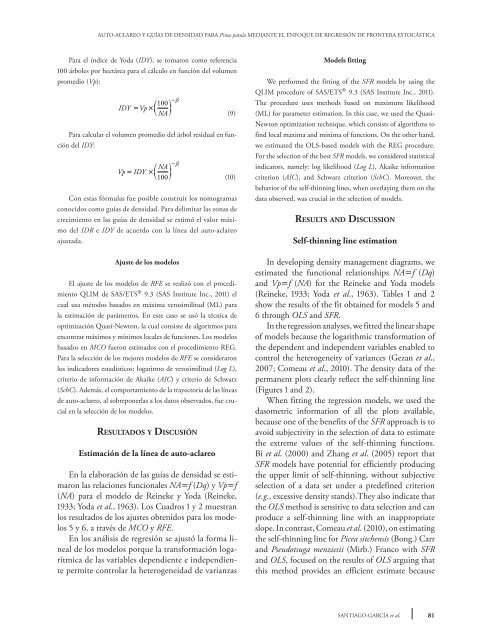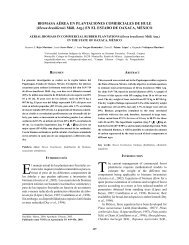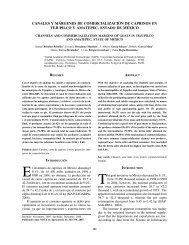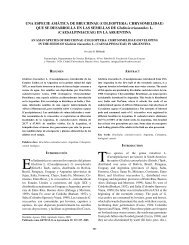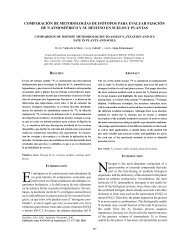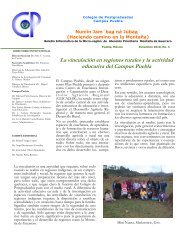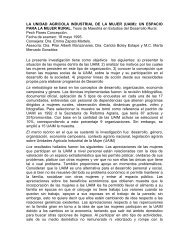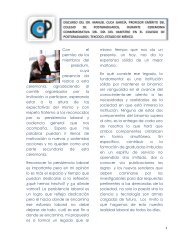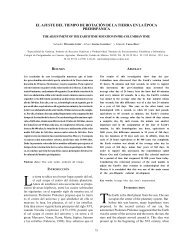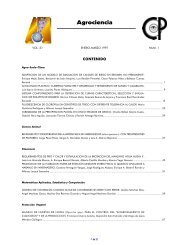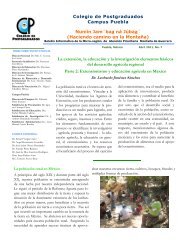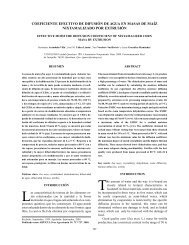AUTO-ACLAREO Y GUÍAS DE DENSIDAD PARA Pinus patula ...
AUTO-ACLAREO Y GUÍAS DE DENSIDAD PARA Pinus patula ...
AUTO-ACLAREO Y GUÍAS DE DENSIDAD PARA Pinus patula ...
Create successful ePaper yourself
Turn your PDF publications into a flip-book with our unique Google optimized e-Paper software.
<strong>AUTO</strong>-<strong>ACLAREO</strong> Y <strong>GUÍAS</strong> <strong>DE</strong> <strong>DE</strong>NSIDAD <strong>PARA</strong> <strong>Pinus</strong> <strong>patula</strong> MEDIANTE EL ENFOQUE <strong>DE</strong> REGRESIÓN <strong>DE</strong> FRONTERA ESTOCÁSTICA<br />
Para el índice de Yoda (IDY), se tomaron como referencia<br />
100 árboles por hectárea para el cálculo en función del volumen<br />
promedio (Vp):<br />
IDY = Vp×<br />
NA<br />
⎛<br />
−β<br />
100⎞<br />
⎜ ⎟<br />
⎝ ⎠<br />
Para calcular el volumen promedio del árbol residual en fun-<br />
ción del IDY:<br />
NA<br />
Vp = IDY × ⎛<br />
−β<br />
⎞<br />
⎜ ⎟<br />
⎝100⎠<br />
(9)<br />
(10)<br />
Con estas fórmulas fue posible construir los nomogramas<br />
conocidos como guías de densidad. Para delimitar las zonas de<br />
crecimiento en las guías de densidad se estimó el valor máxi-<br />
mo del IDR e IDY de acuerdo con la línea del auto-aclareo<br />
ajustada.<br />
Ajuste de los modelos<br />
El ajuste de los modelos de RFE se realizó con el procedi-<br />
miento QLIM de SAS/ETS 9.3 (SAS Institute Inc., 2011) el<br />
cual usa métodos basados en máxima verosimilitud (ML) para<br />
la estimación de parámetros. En este caso se usó la técnica de<br />
optimización Quasi-Newton, la cual consiste de algoritmos para<br />
encontrar máximos y mínimos locales de funciones. Los modelos<br />
basados en MCO fueron estimados con el procedimiento REG.<br />
Para la selección de los mejores modelos de RFE se consideraron<br />
los indicadores estadísticos: logaritmo de verosimilitud (Log L),<br />
criterio de información de Akaike (AIC) y criterio de Schwarz<br />
(SchC). Además, el comportamiento de la trayectoria de las líneas<br />
de auto-aclareo, al sobreponerlas a los datos observados, fue cru-<br />
cial en la selección de los modelos.<br />
ResultAdos y dIscusIón<br />
Estimación de la línea de auto-aclareo<br />
En la elaboración de las guías de densidad se estimaron<br />
las relaciones funcionales NAf (Dq) y Vpf<br />
(NA) para el modelo de Reineke y Yoda (Reineke,<br />
1933; Yoda et al., 1963). Los Cuadros 1 y 2 muestran<br />
los resultados de los ajustes obtenidos para los modelos<br />
5 y 6, a través de MCO y RFE.<br />
En los análisis de regresión se ajustó la forma lineal<br />
de los modelos porque la transformación logarítmica<br />
de las variables dependiente e independiente<br />
permite controlar la heterogeneidad de varianzas<br />
Models fitting<br />
We performed the fitting of the SFR models by using the<br />
QLIM procedure of SAS/ETS 9.3 (SAS Institute Inc., 2011).<br />
The procedure uses methods based on maximum likelihood<br />
(ML) for parameter estimation. In this case, we used the Quasi-<br />
Newton optimization technique, which consists of algorithms to<br />
find local maxima and minima of functions. On the other hand,<br />
we estimated the OLS-based models with the REG procedure.<br />
For the selection of the best SFR models, we considered statistical<br />
indicators, namely: log likelihood (Log L), Akaike information<br />
criterion (AIC), and Schwarz criterion (SchC). Moreover, the<br />
behavior of the self-thinning lines, when overlaying them on the<br />
data observed, was crucial in the selection of models.<br />
Results And dIscussIon<br />
Self-thinning line estimation<br />
In developing density management diagrams, we<br />
estimated the functional relationships NAf (Dq)<br />
and Vpf (NA) for the Reineke and Yoda models<br />
(Reineke, 1933; Yoda et al., 1963). Tables 1 and 2<br />
show the results of the fit obtained for models 5 and<br />
6 through OLS and SFR.<br />
In the regression analyses, we fitted the linear shape<br />
of models because the logarithmic transformation of<br />
the dependent and independent variables enabled to<br />
control the heterogeneity of variances (Gezan et al.,<br />
2007; Comeau et al., 2010). The density data of the<br />
permanent plots clearly reflect the self-thinning line<br />
(Figures 1 and 2).<br />
When fitting the regression models, we used the<br />
dasometric information of all the plots available,<br />
because one of the benefits of the SFR approach is to<br />
avoid subjectivity in the selection of data to estimate<br />
the extreme values of the self-thinning functions.<br />
Bi et al. (2000) and Zhang et al. (2005) report that<br />
SFR models have potential for efficiently producing<br />
the upper limit of self-thinning, without subjective<br />
selection of a data set under a predefined criterion<br />
(e.g., excessive density stands).They also indicate that<br />
the OLS method is sensitive to data selection and can<br />
produce a self-thinning line with an inappropriate<br />
slope. In contrast, Comeau et al. (2010), on estimating<br />
the self-thinning line for Picea sitchensis (Bong.) Carr<br />
and Pseudotsuga menziesii (Mirb.) Franco with SFR<br />
and OLS, focused on the results of OLS arguing that<br />
this method provides an efficient estimate because<br />
SANTIAGO-GARCÍA et al.<br />
81


